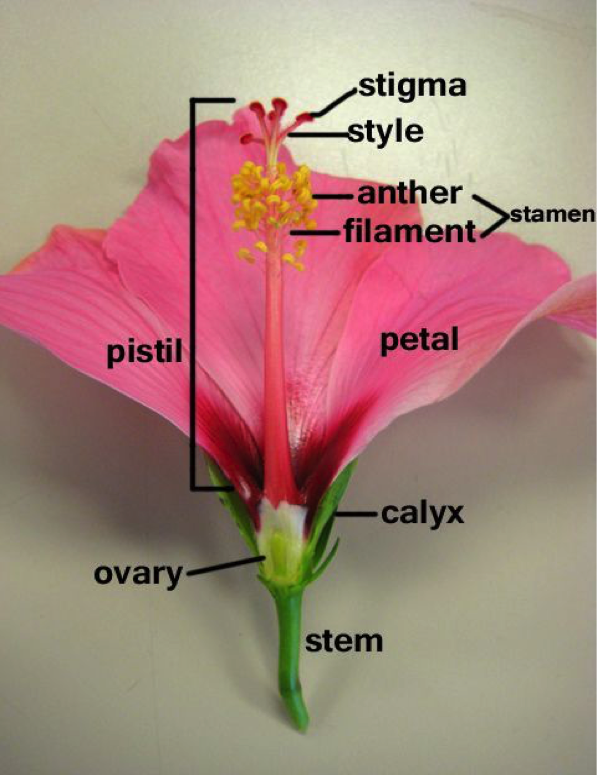Biblical Reminders from the Hibiscus Plant
For about seven or so months of the year, my hibiscus plants need my attention. Though the species that I grow is classified as hibiscus hirtus, there are hundreds of varieties which typically thrive in tropical climates worldwide.1 Because I live in New Jersey, my hibiscus blooms only from June through September every year. Its stunning red flowers are about six to eight inches in diameter. Each hibiscus plant blossoms dozens of flowers during its blooming season, making it quite a beautiful plant.
Plants in the broad hibiscus family share certain flowering characteristics. Whatever the size or color of the flower, it typically will have five separate flower petals of equal size. The filaments are fused, forming part of the upper pistil. Also typical are the five-ribbed seedpods. The flowers themselves untuck as they bloom into flat, round flowers.2
The opening of the hibiscus flower is spectacular. Throughout the spring and into the summer, I fertilize and water them in the direct sun until the stems and leaves of the hibiscus shoot forth. By July the plants are about four feet tall and bushy, full of buds that burst into vibrant red blossoms. The blossoms are oval and grow about four inches, the size of a small dinner plate, with a slim, pink pistil and yellowish anther in its center.

Image courtesy of Colonel Ken Lawson
Labeled parts of the hibiscus plant
The first hibiscus blossom is notable because dozens more quickly follow. Each of my plants blooms several red blossoms at a time, each lasting a few days, and the whole blooming process lasting about six weeks. Hundreds of large, beautiful flowers come and go quickly. Some garden varieties of hibiscus grow and bloom year round, reaching heights of 10 to 15 feet. Mine are seasonal and smaller, in pots, but still enjoyable to care for and behold.

Image courtesy of Colonel Ken Lawson
Hibiscus blooms are about the size of a small dinner plate.
The hibiscus is increasing in popularity. People who have traveled on tropical vacations are often overwhelmed by the beauty and variety of hibiscus, and have discovered how the hibiscus can be cultivated for their enjoyment at home. Some people grow hibiscus competitively, entering them in contests such as the one held by the American Hibiscus Society.
Many hibiscus are low-ground plants, providing spectacular color as a groundcover. Some grow to waist or shoulder length as bushes, like my potted hibiscus plants. Hibiscus growing in tropical climates can grow as high as trees and bloom year round. Historically, the hibiscus has been used in Asia for tanning leather; in Australia for juice and wine; and in traditional Pacific cultures as a sign of a woman’s marital status—a hibiscus flower on the right ear means she is single, on the left ear means she is spoken for. In many cultures, fluids pressed from the hibiscus are used as dyes, ink, and wood stain, with hibiscus bark utilized for cords and ropes.3 In addition to being beautiful, this is a very utilitarian plant.
Biblical Reminders from the Hibiscus
- As the hibiscus and all flowers are fragile, so is human life. The beauty of flowers, like the enjoyments of life, are fleeting.
Job 14:1–2 states, “
Man who is born of a woman is few of days and full of trouble. He comes out like a flower and withers; he flees like a shadow and continues not.
” - We’re instructed to look at the flowers, such as the hibiscus, when fear and worry enter our spirits: “
And why are you anxious . . .? Consider the lilies of the field. . . . But if God so clothes the grass of the field, which today is alive and tomorrow is thrown into the oven, will he not much more clothe you, O you of little faith
” (Matthew 6:28, 30). - Just as hibiscus need attention, feeding, and pruning, so do people. We must feed ourselves both physically and spiritually, and we must prune away those temporary, constraining things that hinder our growth. Jesus said in John 15:1–2, “
I am the true vine, and my Father is the vinedresser. . . . every branch that does bear fruit he prunes, that it may bear more fruit.
” - A hibiscus’ life is short and fragile, but God’s Word used flowers to contrast the eternality of God.
Isaiah 40:6–8 says, “
All flesh is grass, and all its beauty is like the flower of the field. The grass withers, the flower fades, when the breath of the Lord blows on it; surely the people are grass. The grass withers, the flower fades, but the word of our God will stand forever.
”
God takes great care in designing, creating, and sustaining beautiful but common flowers. Much more does the sovereign Creator God care for unique and remarkable human beings who were created in his image and likeness, into whom he breathed the breath of life.
Having earned a doctor of sacred theology degree, Chaplain (Colonel) Ken Lawson is the senior Army chaplain at Fort Dix, New Jersey.
Footnotes
- Les Beers and Jim Howie, Growing Hibiscus (Nashville, TN: Kangaroo Press, 1993); Barbara P. Lawton, Hibiscus: Hardy and Tropical Plants for the Garden (Portland, OR: Timber Press, 2004); and Jaqueline Walker, Hibiscus, (Richmond Hill, Ontario: Firefly Books, 2001).
- Barbara P. Lawton, Hibiscus: Hardy and Tropical Plants for the Garden, 17–18.
- Jaqueline Walker, Hibiscus, 93.
Recommended Resources
- © 2024 Answers in Genesis
- Privacy Policy
- Contact
- About


